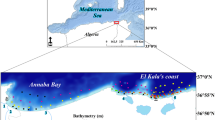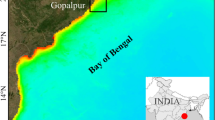Abstract
Oceanic waters of the Northern Arabian Sea experience massive algal blooms during winter–spring (mid Feb–end Mar), which prevail for at least for 3 months covering the entire northern half of the basin from east to west. Ship cruises were conducted during winter–spring of 2001–2012 covering different stages of the bloom to study the biogeochemistry of the region. Phytoplankton analysis indicated the presence of green tides of dinoflagellate, Noctiluca scintillans (=N. miliaris), in the oceanic waters. Our observations indicated that diatoms are coupled and often co-exist with N. scintillans, making it a mixed-species ecosystem. In this paper, we describe an approach for detection of bloom-forming algae N. scintillans and its discrimination from diatoms using Moderate Resolution Imaging Spectroradiometer (MODIS)-Aqua data in a mixed-species environment. In situ remote sensing reflectance spectra were generated using Satlantic™ hyperspectral radiometer for the bloom and non-bloom waters. Spectral shapes of the reflectance spectra for different water types were distinct, and the same were used for species identification. Scatter of points representing different phytoplankton classes on a derivative plot revealed four diverse clusters, viz. N. scintillans, diatoms, non-bloom oceanic, and non-bloom coastal waters. The criteria developed for species discrimination were implemented on MODIS data and validated using inputs from a recent ship cruise conducted in March 2013.








Similar content being viewed by others
References
Balch, W. L., & Haxo, F. T. (1984). Spectral properties of Noctiluca miliaris Suriray, a heterotrophic dinoflagellate. Journal of Plankton Research, 6(3), 515–525.
Banse, K., & McClain, C. R. (1986). Winter blooms of phytoplankton in the Arabian Sea as observed by the Coastal Zone Color Scanner. Marine Ecology – Progress Series, 201–211.
Briyan, A., & Franz. (2013). Algorithm for retrieval of remote sensing reflectance from satellite ocean color sensors. http://oceancolor.gsfc.nasa.gov/WIKI/AtmoCor.html.
Buskey, J. E. J. (1995). Growth and bioluminescence of Noctiluca scintillans on varying algal diets. Journal of Plankton Research, 17, 29–40.
Cannizzaro, J. P., Carder, K. L., Chen, F. R., Heil, C. A., & Vargo, G. A. (2008). A novel technique for detection of the toxic dinoflagellate, Karenia brevis, in the Gulf of Mexico from remotely sensed ocean color data. Continental Shelf Research, 28, 137–158.
do Rosário, G. H., Joaquim, I., Goes, S. G. P. M., Edward, J. B., Subhajit, B., Sushma, P., et al. (2014). Massive outbreaks of Noctiluca scintillans blooms in the Arabian Sea due to spread of hypoxia. Nature Communications, 5, 4862. doi:10.1038/ncomms5862.
Dwivedi, R. M., Raman, M., Parab, S., Matondkar, S. G. P., & Nayak, S. (2006). Influence of northeasterly trade winds on intensity of winter bloom in the northern Arabian Sea. Current Science, 90, 1397–1406.
Dwivedi, R. M., Raman, M., Babu, K. N., Singh, S. K., Vyas, N. K., & Matondkar, S. G. P. (2008). Formation of algal bloom in the northern Arabian Sea deep waters during January–March: a study using pooled in situ and satellite data. International Journal of Remote Sensing, 29, 4537–4551.
Dwivedi, R. M., Chauhan, R., Solanki, H. U., Raman, M., Matondkar, S. G. P., Madhu, V. R., et al. (2012). Study of ecological consequence of the bloom (Noctiluca millaris) in coastal waters of the Northern Arabian Sea. Indian Journal of Geo-Marine Sciences, 14, 304–313.
Gomes Helga., Goes, J.I., Matondkar, S. G. P., Parab, S. G., Al-Azri, A., & Thoppil, P. G. (2010). Unusual blooms of the Green Noctiluca miliaris (Dinophyceae) in the Arabian Sea during the winter monsoon. Indian Ocean: Biogeochemical Processes and Ecological Variability. (Eds), Wiggert, D., Hood, R.R., Naqvi, S.W.A., Smith, S.L., & Brink, K.H., American Geophysical Union Book Series: 347-363.
Gordon, H. R., & Wang, M. (1994). Retrieval of water-leaving radiance, aerosol optical thickness over the oceans with SeaWiFS: a preliminary algorithm. Applied Optics, 33, 443–452.
Hooker S. B., Esaias, W. E., Feldman, G. C., Gregg, W. W., & McClain C. R. (1992). An overview of SeaWiFS and ocean color. In NASA Technical Memorandum, 104566, 1, 24
Hu, C., Feng, L., & Lee, Z. (2013). Uncertainties of SeaWiFS and MODIS remote sensing reflectance: implications from clear water measurements. Remote Sensing of Environment, 133, 15.
Kiørboe, T. (2003). High turnover rates of copepod fecal pellets due to Noctiluca scintillans grazing. Marine Ecology Progress Series, 258, 181–188.
Kiørboe, T., & Titelman, J. (1998). Feeding, prey selection and prey encounter mechanisms in the heterotrophic dinoflagellate Noctiluca scintillans. Journal of Plankton Research, 20, 1615–1636.
Lee, J. K., & Hirayama, K. (1992). Effects of salinity, food level temperature on the population growth of Noctiluca scintillans Macartney. Bulletin of the Faculty of Fisheries Nagasaki University, 71, 163–167 (in Japanese with English abstract).
Madhupratap, M., Prasanna Kumar, S., Bhattathiri, P. M. A., Dileep Kumar, M., Raghukumar, S., Nair, K. K. C., et al. (1996). Mechanism of the biological response to winter cooling in the North Eastern Arabian Sea. Nature, 384, 549–552.
Matondkar, S. G. P., Bhat, S. R., Dwivedi, R. M., & Nayak, S. R. (2004). Indian satellite IRS-P4 (OCEANSAT). Monitoring algal blooms in the Arabian Sea. Harmful Algae News, 26, 4–5.
Prasanna Kumar, S., & Prasad, T. G. (1996). Winter cooling in the Northern Arabian Sea. Current Science, 71, 834–841.
Simon, A., & Shanmugam, P. (2012). An algorithm for classification of algal blooms using MODIS-Aqua data in oceanic waters around India. Advances in Remote Sensing, 1, 35–51.
Siswanto, E., Ishizaka, J., Chandra, T. S., & Miyamura, K. (2013). Detection of harmful algal blooms of Karenia mikimotoi using MODIS measurements: a case study of Seto-Inland Sea Japan. Remote Sensing of Environment, 129, 185–196.
Stramma, L., Johnson, G. C., Sprintall, J., & Mohrholz, V. (2008). Expanding oxygen-minimum zones in the tropical oceans. Science, 320(5876), 655–658.
Stumpf, R. P., Culver, M. E., Tester, P. A., Tomlinson, M., Kirkpatrick, G. J., & Pederson, B. A. (2003). Monitoring Karenia brevis blooms in the Gulf of Mexico using satellite ocean color imagery and other data. Harmful Algae, 2, 147–160.
Tomlinson, M. C., Wynne, T. T., & Stumpf, R. P. (2009). An evaluation of remote sensing techniques for enhanced detection of toxic dinoflagellate, Karenia brevis. Remote Sensing of Environment, 113, 598–609.
Zakaria, A. M., & Ibrahim, M. (2007). First report on Noctiluca scintillans blooms in the Red Sea off the coasts of Saudi Arabia: consequences of eutrophication. Oceanologia, 49(3), 337–351.
Acknowledgments
Authors acknowledge with thanks the encouraging technical comments by Dr. Shailesh Nayak, Secretary Ministry of Earth Sciences. Thanks are also due to Dr. Joaquim Goes (Professor, Lamont Doherty Earth Observatory at Columbia University, New York (USA)) and Dr. S.G. Prabhu Matondkar (National Institute of Oceanography, Goa (India)) for critically reviewing this paper. Participation of a team of scientists from Space Applications Centre (Ahmedabad), National Institute of Oceanography (Goa), and Centre of Marine Living Resources and Ecology (Kochi) during the ship cruises over 10 years is also gratefully acknowledged. URL http://oceancolor.gsfc.nasa.gov/ and SeaDAS were used for downloading and processing MODIS data. The access to the same is acknowledged.
Author information
Authors and Affiliations
Corresponding author
Rights and permissions
About this article
Cite this article
Dwivedi, R., Rafeeq, M., Smitha, B.R. et al. Species identification of mixed algal bloom in the Northern Arabian Sea using remote sensing techniques. Environ Monit Assess 187, 51 (2015). https://doi.org/10.1007/s10661-015-4291-2
Received:
Accepted:
Published:
DOI: https://doi.org/10.1007/s10661-015-4291-2




